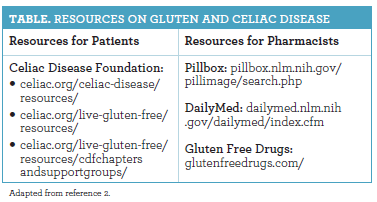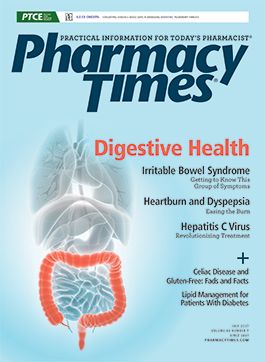Publication
Article
Pharmacy Times
Celiac Disease and Gluten-Free: Identifying Fad, Facts, and Fiction
Author(s):
For the millions of individuals who have celiac disease (CD), a gluten-free diet (GFD) is essential.
For the millions of individuals who have celiac disease (CD), a gluten-free diet (GFD) is essential.1 CD is an immune reaction in the small intestine to eating gluten, a protein found in barley, wheat, and rye. Over time, this reaction damages the small intestine’s lining and prevents absorption of necessary nutrients, possibly resulting in malabsorption, which can affect growth and development in children; cause fatigue, diarrhea, weight loss, anemia, and bloating; and lead to serious complications.2
CD’s prevalence is increasing, possibly due to growing awareness of the disease in the medical community. However, the growth of the gluten- free industry continues to outpace the knowledge of medical professionals.
Market research has shown that those who buy most gluten-free products do not have CD.1 A recent survey of more than 1500 adults across the United States found that 36% selected gluten-free products for no medical reason. The survey also revealed the following reasons participants opted for gluten-free products1:
- Healthier option: 26%
- Digestive health: 19%
- Someone in the family has a gluten sensitivity: 10%
- Gluten sensitivity: 8%
For a detailed plot of search histories using the terms “gluten-free” and “celiac disease” from 2004 to 2017, see the figure3. Because GFDs are growing in popularity, this article will focus on separating the facts from common inaccuracies regarding CD and a GFD.
FICTION: A GFD is healthier and does not have any risks or disadvantages.
FACT: There are no data to support the health benefits of a GFD in individuals without a diagnosis of wheat allergy, CD, or gluten sensitivity. There may be some issues with adopting a GFD without the guidance of a health care provider or dietician.1

Adopting a GFD unnecessarily may lead to vitamin and nutrient deficiencies, specifically in terms of B vitamins, folate, and iron. Also, gluten-free foods typically contain more fat and sugar than gluten-containing foods. Being overweight, suffering from obesity or metabolic syndrome, and new-onset insulin resistance have all been identified after adoption of a GFD. There is also evidence that gluten-free foods may expose consumers to toxins such as arsenic, which is frequently found in inorganic forms of rice. This can be an issue for individuals on a GFD because rice is a common ingredient in gluten-free processed foods. Furthermore, products marketed as gluten-free are often more expensive than their gluten-containing counterparts. Finally, those who have initiated a GFD and have had some symptom relief may be hesitant to resume gluten intake to allow for proper diagnostic testing.1
FICTION: A GFD is warranted for at-risk infants or individuals with a close relative with CD.
FACT: Individuals at risk for CD should not adopt a GFD without proper diagnostic testing.1 There are no data to support a GFD in children who have no symptoms and who do not have CD. Furthermore, there are no data to support delaying the introduction of gluten to infants to prevent CD.1

RECOMMENDATIONS FOR PHARMACISTS
If patients are looking to adopt a GFD to alleviate symptoms or if they have already switched over, recommend that they speak with their health care provider for proper diagnostic testing and guidance.1 Referral to a dietician is recommended for patients with a wheat allergy or nonceliac gluten sensitivity or who are considering a GFD. A dietitian can ensure that they are receiving proper nutrition.1 Recommending a GFD should be based on good judgment and proper counseling.1
GLUTEN IN MEDICATIONS
Medications, specifically excipients, can be a source of gluten. However, manufacturers are not required to publish the sources of excipients in a database. As a result, if anyone wants to determine whether a medication is gluten-free, they must contact the manufacturer, which can be difficult.4
When the gluten status of a medication needs to be determined, the Celiac Disease Foundation (CDF) recommends people first look at the excipients, specifically starch, which is the most likely source of gluten contamination.4 However, it is important to note that the word “starch” may be broadly used for any source of starch. The CDF recommends using the databases Pillbox (pillbox. nlm.nih.gov/pillimage/search.php) and DailyMed (dailymed.nlm. nih.gov/dailymed/index.cfm). These resources are maintained by the National Institutes of Health and can be helpful in determining the potential for gluten contamination.4 An additional resource that lists gluten-free medications is glutenfreedrugs.com.5
PROVIDING PATIENT RESOURCES
Although patients may know that bread and pasta contain gluten, they may not know that other food items, such as soy sauce and pickles, also may contain gluten. The CDF can help identify gluten-containing foods, gluten-free meal plans, and online gluten-free communities. These resources can provide recipes, advice, and support. For a list of resources for patients and pharmacists, see the table.
Anyssa Garza received her doctor of pharmacy degree from the University of Texas at Austin before becoming the director of pharmacy for a Central Texas Department of Aging andDisability facility. She now serves as the vice president of content and patient education programs at RxWiki. In this role, she provides patients with medication information and medical knowledge that will contribute significantly to the quality of care they receive and improve their quality of life and health outcomes. Her work focuses on educating patients and providing them with the resources they need to navigate the overwhelming and complex health system and their health care issues. She also is an adjunct assistant professor at the University of Texas at Austin College of Pharmacy.
References
- Reilly NR. The gluten-free diet: recognizing fact, fiction, and fad. J Pediatr. 2016;175:206-210. doi: 10.1016/j.jpeds.2016.04.014.
- Celiac disease. Mayo Clinic website. mayoclinic.org/diseases-conditions/celiac-disease/home/ovc-20214625. Accessed April 22, 2017.
- Gluten free. Google Trends website. trends.google.com/trends/explore?date=all&geo=US&q=gluten%20free,%2Fm%2F0h1pq. Accessed April 22, 2017.
- Gluten in medication. Celiac Disease Foundation website. celiac.org/live-gluten-free/glutenfreediet/gluten-medication/. Accessed April 22, 2017.
- Gluten Free Drugs website. glutenfreedrugs.com/. Accessed April 22, 2017.







